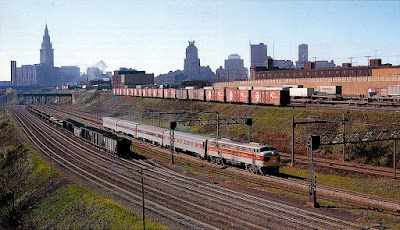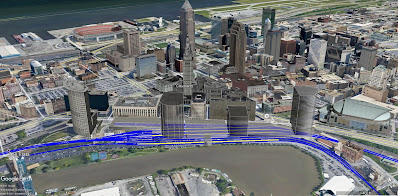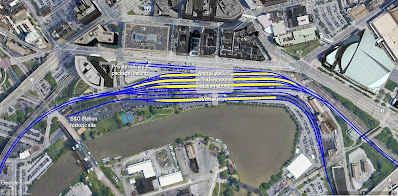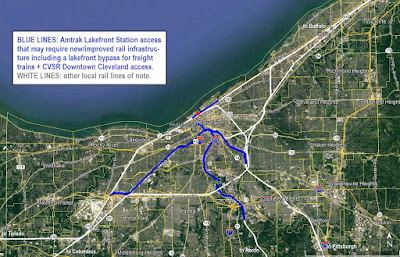All Aboard Ohio’s Board of Directors voted unanimously this week to favor Tower City Center as the site for a proposed Amtrak mini-hub. But the Board of the non-profit passenger rail and transit advocacy association noted that it would not oppose development of the existing Amtrak station site as the transportation hub.
The statewide group said that Amtrak’s proposed mini-hub at Cleveland makes a major capital improvement like this justifiable. It didn’t make sense with Amtrak running just one or two trains each day in the middle of the night. But Amtrak’s proposed Cleveland mini-hub would bring significant new passenger traffic and business activity to downtown Cleveland.
The Board said the timing of its statement urging restoration of Tower City Center, the former Cleveland Union Terminal (CUT), as the city main railroad terminal was motivated by these factors:
- Amtrak is proposing new routes and expanded services on existing routes that could grow its passenger rail services at Cleveland from four nightly trains to 22 trains a day, arriving and departing around the clock. Amtrak passenger boardings at Cleveland may grow from 50,000 per year (or one-fifth of Greyhound’s traffic here) currently to 500,000-1 million (or up to one-fifth of Hopkins International Airport’s annual traffic). This passenger traffic is based on rail service levels existing at other mid-sized metro areas;
- Development is possibly on the horizon for the Riverview parking lots, between Huron and Canal roads, that could end further consideration of the remaining opportunity for restoring Tower City Center as a railroad station unless actions were taken now to preserve a railroad right of way below any development and inclusion of station facilities in any development planned by Bedrock Real Estate or its partners and affiliates;
- Sherwin-Williams has donated to the City of Cleveland the property on which its John G. Breen Technology Center sets, prior to relocation to Brecksville in 2024. With the research facility gone, it allows for the western throat of an Amtrak station at Tower City Center to be built around the Stokes Federal Courthouse.
 |
| Moments after departing Cleveland Union Terminal (now Tower City Center) in 1971, Erie-Lackawanna’s afternoon commuter train picks up speed, bound for Youngstown (Dave Mackay). |
All Aboard Ohio said the biggest reason for developing Amtrak’s mini-hub at Tower City Center is because the region’s rail transit and bus hub is already in and next to Tower City. Plus, the proximity of many businesses and attractions, the potential for co-locating with an expansion of the Cuyahoga Valley Scenic Railroad, having a station free of interference from freight trains and a crossing of the Cuyahoga River that won’t further inconvenience boaters and commercial shipping are important reasons, too.
The nonprofit organization said it spoke up now because time could soon run out on considering Tower City Center as an Amtrak mini-hub. Future development may possibly encroach on the Riverview parking lots between Huron and Canal roads. This may well be the last opportunity to restore passenger railroad service to what was the Cleveland Union Terminal. Cleveland has a good back-up location on the lakefront, but All Aboard Ohio said it would like to see the better location explored now before it’s too late.
Here is additional detail on why All Aboard Ohio said Tower City Center is a superior location for an Amtrak mini-hub station in Downtown Cleveland:
- Greater Cleveland’s public transportation hub is located at Tower City Center and outside its front door on Public Square. Not only is Tower City the hub of all rail rapid transit lines, but the downtown Cleveland routes of the Greater Cleveland Regional Transit Authority (GCRTA), Akron Metro RTA, Laketran, Portage Area RTA and Stark Area RTA all converge on Public Square.
- Tower City Center is also within a five-minute walk of more employers, hotels, restaurants, shops and attractions than the lakefront station site. And it offers the potential for air-rights development above the station, tracks and related facilities something that is more complicated above tracks that also host freight trains, especially those carrying hazardous materials, as is the case on the lakefront.
- Railroad rights of way accessing Tower City Center remain largely intact even though tracks were removed shortly after railroad passenger service to CUT ended in 1977. They are mostly owned by GCRTA and exist parallel to GCRTA rail rapid transit tracks which Amtrak trains cannot use due to federal regulations regarding crash impact standards as well as insufficient lateral clearances.
- The 2002 construction of the Stokes Federal Courthouse on CUT’s west throat had presented an obstacle. But during the West Shore Corridor Alternatives Analysis a decade ago, Parsons Brinckerhoff (now WSP) showed that railroad commuter trains from Lorain could enter a station built on the former CUT coach yards, now the Riverview parking lot. It required building above Canal Road to avoid the Stokes Federal Courthouse. But now, Canal Road can be rerouted or removed and the western throat to a Tower City Amtrak station built where Sherwin-Williams Breen Technology Center is now located after its probable demolition sometime after 2024.
- Amtrak officials expressed to All Aboard Ohio their desire for having a station in Cleveland with operations that will have to contend with few if any freight trains. A station at Tower City Center would offer that. To enjoy this same benefit at a lakefront station would involve rerouting freight trains to a ?Lakefront Bypass? just south of downtown Cleveland, requiring the investment of about $200 million to add tracks to existing Norfolk Southern rights of way.
- Tower City Center offers the potential for a shared station facility with the Cuyahoga Valley Scenic Railroad (CVSR), offering enhanced visitor access to the Cuyahoga Valley National Park. CVSR has long desired an extension of their train services to downtown Cleveland which, according to past studies, would result in annual ridership growing from about 200,000 passengers per year to more than 300,000. Direct CVSR service to the lakefront is not operationally or economically feasible.
- Another advantage of a Tower City Center station is that trains would cross the busy, navigable portion of the Cuyahoga River on a high-level bridge. On the lakefront, that crossing is via a drawbridge that must be raised and lowered every time any boat larger than a small recreational watercraft seeks passage. The railroad has the legal right of way here, which causes significant traffic jams of boats and larger lake carrier ships. Increasing rail passenger traffic on the lakefront will worsen this waterway congestion and negatively impact commercial shipping.
 |
| Cleveland’s tiny Amtrak station on the lakefront is served only by four pre-dawn trains. Yet they provide a brief bit of nightlife to downtown’s windswept lakefront as seen here in 2015 (KJP). |
Lastly, Greyhound bus service is likely to follow Amtrak into a new or expanded station facility in Cleveland, as has happened throughout Ohio and the nation. Greyhound traffic is about 250,000 passenger boardings per year in Cleveland. A multi-modal transportation center that combines Greyhound with an Amtrak mini-hub would consolidate passenger boardings and improve connectivity between transportation modes. At stations where Amtrak and Greyhound co-locate, total passenger boardings have typically increased by about 20 percent.
While the former CUT rights of way are mostly intact, some uses have encroached upon the right of way in the past four decades. In nearly all situations, there is sufficient room for the new uses and the restored railroad track to co-exist. For example, through Ohio City, the CUT right of way was built to accommodate six tracks (two for rapid transit and four for railroad). There is room to shift the existing Red Line Greenway closer to Columbus Road to allow for two Amtrak tracks to be constructed. In other locations, such as on the east side of Tower City, RTA tracks and electrical installations would have to be moved slightly to accommodate Amtrak tracks.
Here is 2019 passenger boarding data (and change from the prior year) for Amtrak stations that have Amtrak service levels in the 14-28 trains per day range, plus 2019 Cleveland Hopkins International Airport passenger enplanements data:
- Albany, NY 26 trains/day 806,960 boardings +0.08%
- Seattle, WA 14 trains/day 682,132 boardings -0.06%
- Milwaukee, WI 16 trains/day 639,713 boardings +5.8%
- Portland, OR 16 trains/day 585,344 boardings +1.6%
- Lancaster, PA 28 trains/wkday, 16 Sa/Su 577,305 boardings +1.7%
- St. Louis, MO 14 trains/day 354,304 boardings -2%
- Cleveland Hopkins International Airport 4,894,541 enplanements +4%
With an Amtrak station, Cuyahoga Valley Scenic Railroad station and Greyhound station all combined under one roof at Tower City Center the total passenger traffic from all three modes could exceed 1.3 million boardings per year.
END
- Haslam email preempts City, County at stadium debate
- NE Ohio projects get historic wins from tax credits
- Haslams announce Brook Park stadium-area development partner, updated plans
- Old Brooklyn structures OK’d for demolition
- Shoreway Tower has construction in view for 2025
- North Collinwood ‘historic’ modular townhomes OK’d











Comments are closed.